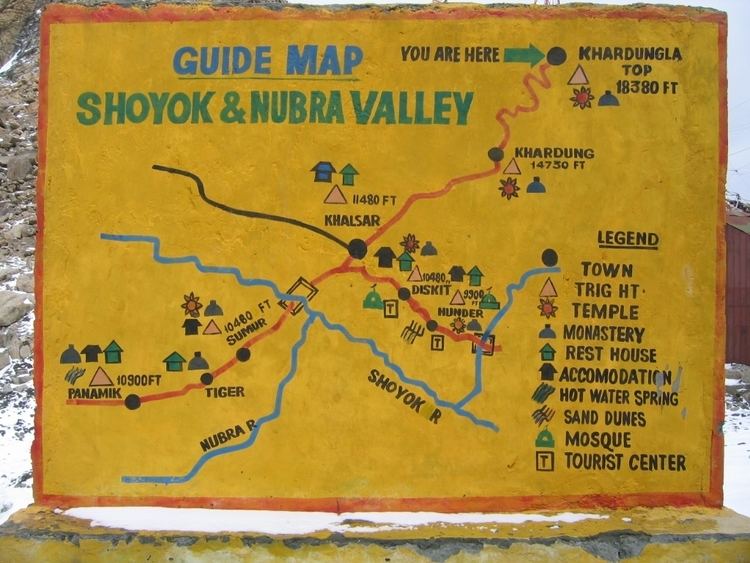Time zone IST (UTC+5:30) Population 859 (2011) | Tehsil Nubra Census code 931 | |
 | ||
Weather -3°C, Wind S at 11 km/h, 46% Humidity | ||
Tegar, also known as Tiggar, is a high-altitude village in the Leh district of Jammu and Kashmir, India. It is located in the Nubra tehsil, in the Nubra Valley of Ladakh region.
Contents
Map of Tegar 194401
Buddhism
Tegar is a Buddhist village on the fringes of the Tibetan Cultural Area.
There are two sects of Buddhists living in the village. Each sect has specific affiliation to the nearby monasteries of the sect. One set of villagers belong to the Gelukpa Order or Yellow Hat Sect of Buddhists, and they are under the religious patronage of the Samtsaling Monastery, which is 3 km away from the village. The second set of people, from a hamlet of the village belong to the Diskit Gompa, the oldest and the largest monastery. Both monasteries own land in the village, which are given on tenement to the villagers for rising agricultural crops. Every month, the Lapsang ritual is observed by the villagers, which is presided by the monks deputed by the particular Order of the monastery. The villagers also attend the monastery of their affiliation on all festival events. In addition to the monasteries, there are two Manekhangs or temples, one of each sect, in the village. A monk is appointed as priest for each of these temples and they are drawn from the monasteries of the same Order.
Demographics
According to the 2011 census of India, Tiggar has 204 households. The effective literacy rate (i.e. the literacy rate of population excluding children aged 6 and below) is 55.08%.
Geography
The hills on which the village is situated forms the southern slopes of the Kharakorum Range. The geological formation of the hill has been recorded as granite formations, and named after the hill peak of Teger, as Teger Granites. The granites consists of two types of micas – muscovite and biotite. This formation is unlike the granite and volcanic formation of the Ladakh granite and Shylock Volcanic. Its formation has been attributed to the thermal metamorphosis process due to which the rocks attained the andalusitic horn-felsic form.
Teger is one of the villages in the Nubra Valley (average elevation of about 10,000 feet), known as the valley of orchard and flowers, on the silk route, and caravans used to halt here while travel ling from to and from Central Asia and Kashmir; the other important villages on this route are Khardong, Khalsar, Tirit, Sumoor, Pinchemik, Chamshein, Tirisha and Panamik (see map). The principal hotels in the village are Hotel Yarab Tso and the Hotel Rimo which are about 500 m away from the village. It is under the Diskit administrative Sub-Division and the main approach road to the valley passes through the highest Khardongla pass (18,380 ft), which is accessible throughout the year.
